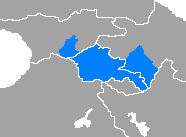Armenian language
![]()
Armenian is a redirect to this article. For other meanings, see Armenian (disambiguation).
The Armenian language (Armenian: Հայերեն Hajeren) is a branch of the Indo-European languages.
There are four forms of Armenian:
- Old Armenian [xcl] (Գրաբար - also called Grabar), which has been in written evidence since the 5th century. It was used as a literary language until the 19th century, and in the ecclesiastical sphere it is still in use today (e.g. in church services). A rich literature on theological themes, historical events, poetry and epic poetry has been handed down in this language.
- Middle Armenian/Kilician Armenian [axm] (Միջին հայերէն Mijin hayeren) is the transitional language form to today's modern Armenian, lasting from the 12th to the 18th century, which developed in parallel with the frozen liturgical language of Old Armenian as an everyday language.
- Eastern Armenian [hye] (Արևելահայերեն Arevelahayeren), the official language of the Republic of Armenia and the internationally unrecognized Republic of Arzakh, also spoken by the Armenian community in Iran, Georgia, Russia, and the former USSR in general.
- Western Armenian [hyw] (Արեւմտահայերէն Arevmtahayeren), originally native to Anatolia, is still spoken by many Armenians in the diaspora after the genocide of Armenians in the Ottoman Empire, especially in Lebanon and the United States.
Armenian has vocabulary similarities with Greek (many parallels in etymological roots), which is why a closer relationship within the Indo-European languages is assumed (see also Balkan Indo-European). Armenian also contains many loanwords from Iranian languages (Parthian, Middle Persian, Persian).

Present-day areas with Armenian as the majority language.
Speaker Numbers
The total number of speakers is about 9 million, of which just over 3 million live in Armenia (2014), 1,182,388-2,900,000 in Russia (2010), 1,000,366-1,500,000 in the USA, 320,000 in Syria (1993), 248,929 in Georgia (2002), 170,800 in Iran (1993), 150,000 in Lebanon (2014), just under 140.000 in the Nagorno-Karabakh Republic (2002), just under 100,000 in Ukraine, 70,000 in France, 60,000-90,000 in Germany (2015), 60,000 in Turkey (2014), 60,000 in Iraq, 35,790 in Canada (2016), 8,000 in Jordan (1971), 3,000 in Israel (1971), 2,740 in Cyprus (1987), and other speakers in the diaspora, such as in Romania and Hungary.
Scripture
Armenian is written with its own Armenian alphabet, which was developed in the 5th century by the monk Mesrop Mashtoz. It consists of 39 (originally 36) letters.
Search within the encyclopedia